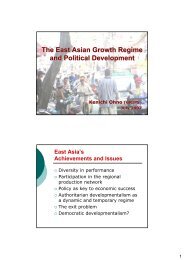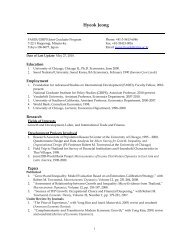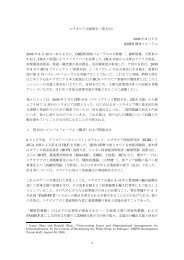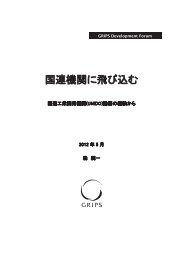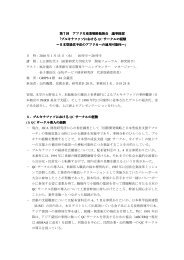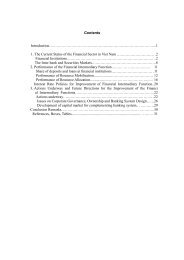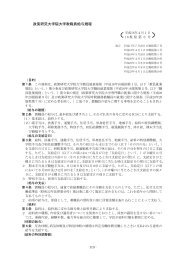Evidence from Firm-level Data in Vietnam
Evidence from Firm-level Data in Vietnam
Evidence from Firm-level Data in Vietnam
You also want an ePaper? Increase the reach of your titles
YUMPU automatically turns print PDFs into web optimized ePapers that Google loves.
Besides TFP, we also use labor productivity as a measure of productivity of firms <strong>in</strong> f<strong>in</strong>d<strong>in</strong>g theeffect of productivity on their export<strong>in</strong>g behavior. In the pooled probit model whose results are reported <strong>in</strong>column (4), labor productivity shows itself as a determ<strong>in</strong>ant with a negative effect on the probability ofexport<strong>in</strong>g with the significance <strong>level</strong> of 5 per cent. The <strong>level</strong> of the marg<strong>in</strong>al effect of this factor is even largerwhen we estimate <strong>in</strong> the Heckman’s dynamic random-effects probit model and the evidence is even strongerwhen it is statistically significant at 1 per cent. The effect derived <strong>in</strong> the estimation for the sub-sample ofno-status-switchers also shows a negative sign. However, it is not statistically significant.<strong>Firm</strong> size and capital <strong>in</strong>tensity are factors that have strong evidence as good predictors for exportstatus of firms. A firm hav<strong>in</strong>g larger capital scale <strong>in</strong> a year is more likely to be an exporter the next year. Thisevidence can be confirmed by the results of all the estimation specifications we run and at 1 per cent ofsignificance <strong>level</strong>. However, the relation between past capital <strong>in</strong>tensity and recent export status is negative.This effect is highly significant. This implies those firms that use labor-<strong>in</strong>tensive technology have higherprobability to export.It is also shown <strong>in</strong> the estimation results, especially those <strong>in</strong> estimations with value added perworker be<strong>in</strong>g used as a measure of productivity, that firm age is a predictor of export probability. The signs ofcoefficients of age and age squared <strong>in</strong> column (5) are positive and negative, respectively. This fact impliesthat firms with more years of experience <strong>in</strong> bus<strong>in</strong>ess are more likely to serve foreign markets via export<strong>in</strong>g,and the marg<strong>in</strong>al value of this experience deteriorates over time. This is also supported by the results <strong>in</strong>column (6). However, when TFP is <strong>in</strong>cluded <strong>in</strong> the set of <strong>in</strong>dependent variables <strong>in</strong> the place of laborproductivity, this evidence can be seen only <strong>in</strong> the estimation <strong>in</strong> the sub-sample of no-status-switchers.We also have evidence to argue that firms with more skilled labors are more likely to export. Theeffect of average wage, which we use to proxy for labor skill, is positive <strong>in</strong> all estimation specifications, andstatistically significant at standard <strong>level</strong>s <strong>in</strong> our preferred specification that <strong>in</strong>cludes labor productivityvariable, as well as <strong>in</strong> the sub-sample of firms with persistent export status. <strong>Firm</strong>s with foreign capital are alsomore likely to be exporters. This evidence is significant <strong>in</strong> all of our preferred specifications at 1 per cent<strong>level</strong>.The estimation results also give h<strong>in</strong>ts about firms <strong>in</strong> which <strong>in</strong>dustries hav<strong>in</strong>g more chances to export.As compared to firms <strong>in</strong> “other <strong>in</strong>dustries” which we take as reference <strong>in</strong>dustry, firms <strong>in</strong> Garments, Leather,Textiles,Food and Beverage, and Wood and Wood Products <strong>in</strong>dustries have higher probability of export<strong>in</strong>g.The coefficients of these <strong>in</strong>dustry dummies are positive and statistically significant at standard significance<strong>level</strong>s. There are also significant evidence about the difference <strong>in</strong> export<strong>in</strong>g probability of firms <strong>in</strong> Paper andPaper Products, Chemical and Chemical Products, and Metals and Metal Products <strong>in</strong>dustries as compared tothat of the reference <strong>in</strong>dustry. The coefficients of dummy variables of these <strong>in</strong>dustries are negative. Other<strong>in</strong>dustries show no statistically significant difference. Regard<strong>in</strong>g to regional difference, we have nostatistically significant evidence. Besides, when we deal with time dummies, we see that there are morechances for firms to export <strong>in</strong> the year 2004, with the significance <strong>level</strong> of 1 per cent for the coefficient of thedummy for the year 2004 when the year 2003 be<strong>in</strong>g taken as reference year. Effects of <strong>in</strong>teraction variablesare also estimated to elaborate further effect details. However, there are no substantial changes <strong>in</strong> the results.Therefore, we choose not to report them.We now turn to the discussion of these f<strong>in</strong>d<strong>in</strong>gs. About the important role of lagged export status <strong>in</strong>21



